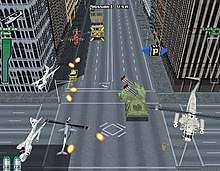Zero Gunner
Zero Gunner is a shoot 'em up developed by Psikyo and released in 1997. The arcade game allows for eight-way movement using a joystick and supports up to two players at a time. It was notable for its lock on targeting mechanic that allowed players to rotate around targets. The game was succeeded by a sequel, Zero Gunner 2 for the Sega NAOMI/Dreamcast.
| Zero Gunner | |
|---|---|
 | |
| Developer(s) | Psikyo |
| Publisher(s) | Psikyo |
| Platform(s) | Arcade (Model 2) |
| Release | 1997 (Arcade / Model 2) |
| Genre(s) | Shoot 'em up |
| Mode(s) | Single player, multiplayer |
| Arcade system | Sega Model 2 |
Story
In the future date of 2016, worldwide martial law is initiated when a widespread terrorist organization overthrew and took control of the world's military authorities. A group of ace helicopter pilots are secretly amassed in a special forces squadron called ZERO to travel around the world and destroy the occupied terrorist forces.
Reception
In Japan, Game Machine listed Zero Gunner on their February 15, 1998 issue as being the sixth most-successful arcade game of the year.[1]
References
- "Game Machine's Best Hit Games 25 - TVゲーム機ーソフトウェア (Video Game Software)". Game Machine (in Japanese). No. 558. Amusement Press, Inc. 15 February 1998. p. 21.